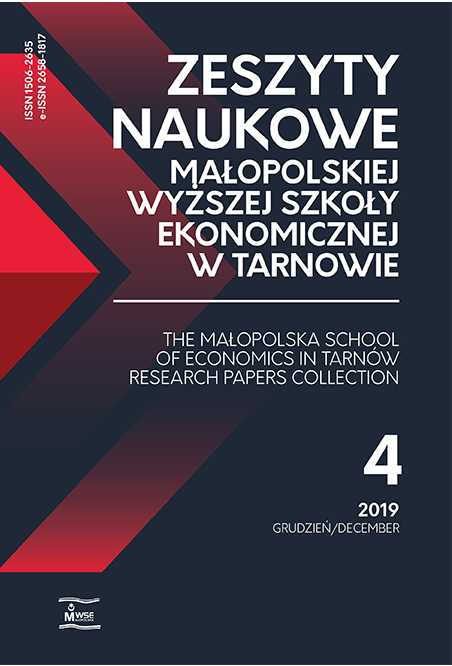Abstract
The functioning and development of an enterprise requires an appropriate level of management that can be analyzed on the basis of financial data reported by the entity. The article presents the concept of measuring the management level using the labour productivity indicator and the management level indicator. These are indicators derived from the model of the analytical production function, integrating a number of economic quantities in the field of financial analysis. This function is a financial model of natural production processes taking place in enterprises and consistent with classic cost accounting. From the point of view of the company’s financial equilibrium, the question arises whether these indicators reflect the financial position of the company well enough so that they can be used to assess the risk of bankruptcy of the company. The aim of the study is a comparative analysis of the dynamics of indicators: level of management and labour productivity in enterprises threatened by collapse and those enterprises retaining the ability to continue their operational activities. The second group of enterprises was chosen using selected methods of discriminant analysis.
References
Antonowicz, P. (2007). Metody oceny i prognoza kondycji ekonomiczno-finansowej przedsiębiorstw. Gdańsk: Ośrodek Doradztwa i Doskonalenia Kadr. ISBN 9788374264112.
View in Google Scholar
Boratyńska, K. (2009). Przyczyny upadłości przedsiębiorstw w Polsce. Ekonomiczne Problemy Usług, 39, 450–457.
View in Google Scholar
Dobija, M. (2016). Ekonomia pracy, wynagrodzeń i racjonalnych nierówności – laboryzm. Nierówności Społeczne a Wzrost Gospodarczy, 47, 25–52 DOI: 10.15584/nsawg.2016.3.2.
View in Google Scholar
Hadasik, D. (1998). Upadłość przedsiębiorstw w Polsce i metody jej prognozowania. Prace Habilitacyjne nr 153. Poznań: Wydawnictwo Akademii Ekonomicznej.
View in Google Scholar
Hamrol, M., Czajka, B., Piechocki, M. (2004). Upadłość przedsiębiorstwa – model analizy dyskryminacyjnej. Przegląd Organizacji, 6, 35–39.
View in Google Scholar
Hołda, A., Micherda, B. (2007). Kontynuacja działalności jednostki i modele ostrzegające przed upadłością. Warszawa: Krajowa Izba Biegłych Rewidentów. ISBN 9788389255242.
View in Google Scholar
Korol, T. (2010). Systemy ostrzegania przedsiębiorstw przed ryzykiem upadłości. Warszawa: Wolters Kluwer Polska. ISBN 9788375267358.
View in Google Scholar
Kozioł, W. (2011). Stała potencjalnego wzrostu w rachunku kapitału ludzkiego. Nierówności Społeczne w Wzrost Gospodarczy, 19, 252–260.
View in Google Scholar
Mączyńska, E. (1994). Ocena kondycji przedsiębiorstwa (uproszczone metody). Życie Gospodarcze, 38, 42–45.
View in Google Scholar
Nowak, E. (2008). Rachunkowość jako źródło informacji o sytuacji finansowej przedsiębiorstw w ocenie zagrożenia upadłością. Barometr Regionalny. Analizy i Prognozy, 2(12).
View in Google Scholar
Pieńkowska, M. (2005). Ujęcie upadłości w teorii przedsiębiorstwa. In: E. Mączyńska (ed.). Ekonomiczne aspekty upadłości przedsiębiorstw w Polsce. Warszawa: Szkoła Główna Handlowa.
View in Google Scholar
Prusak, B. (2005). Nowoczesne metody prognozowania zagrożenia finansowego przedsiębiorstw. Warszawa: Difin. ISBN 8372515247.
View in Google Scholar
Szczerbak, M. (2007). Przyczyny upadłości przedsiębiorstw w Polsce. In: B. Prusak (ed.). Ekonomiczne i prawne aspekty upadłości przedsiębiorstw. Warszawa: Difin. ISBN 9788372517685.
View in Google Scholar
Wojnar, J. (2014). Ocena skuteczności modeli analizy dyskryminacyjnej do prognozowania zagrożenia finansowego spółek giełdowych. Zeszyty Naukowe Małopolskiej Wyższej Szkoły Ekonomicznej w Tarnowie, 24(1), 219–231.
View in Google Scholar
© Copyright by Małopolska School of Economics in Tarnów. The articles are available under the Creative Commons Attribution NonCommercial-NoDerivatives 4.0 International License


